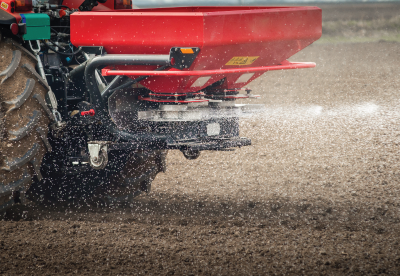Maintaining fertile soil can be frustrating during a nitrogen fertilizer shortage. Many growers have been encountering empty shelves, back logged suppliers, and higher prices. Thankfully, understanding how the nitrogen cycle works can shift our focus to supporting the natural nitrogen factories already living in our soil...bacteria!
Earth’s atmosphere is around 78% nitrogen. This nitrogen is bound up in triple bonded N2 molecules that plants are not able to metabolize on their own. Plants rely on soil-based microorganisms to break down these N2 molecules into nitrogen compounds that are biologically and chemically available to them.
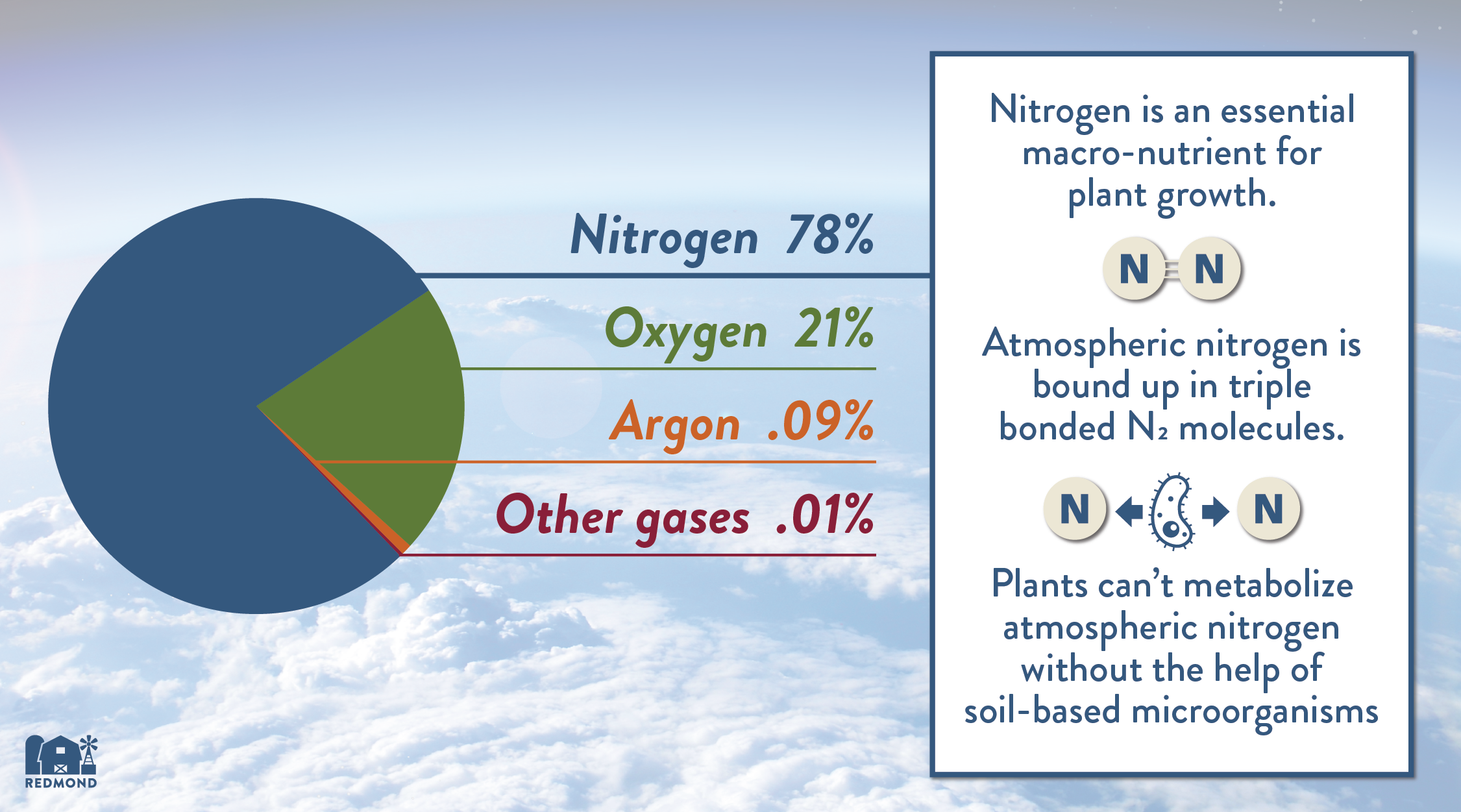
How Does Atmospheric Nitrogen Get Into the Soil?
There are a couple of natural and man-made processes that drive nitrogen into your soil:
- Lightning- Lightning energizes atmospheric nitrogen and oxygen and creates nitrogen oxides. According to the University of Minnesota Extension (UMN) 5-10% of the nitrogen in our soil is created by lightning.
- Vehicle and Industrial Emissions: The other 90-95% of nitrogen in the soil comes from man-made sources like vehicle and industrial emissions (UMN).
- Precipitation- Rain and snow collect and drive these nitrogen compounds down into the soil.
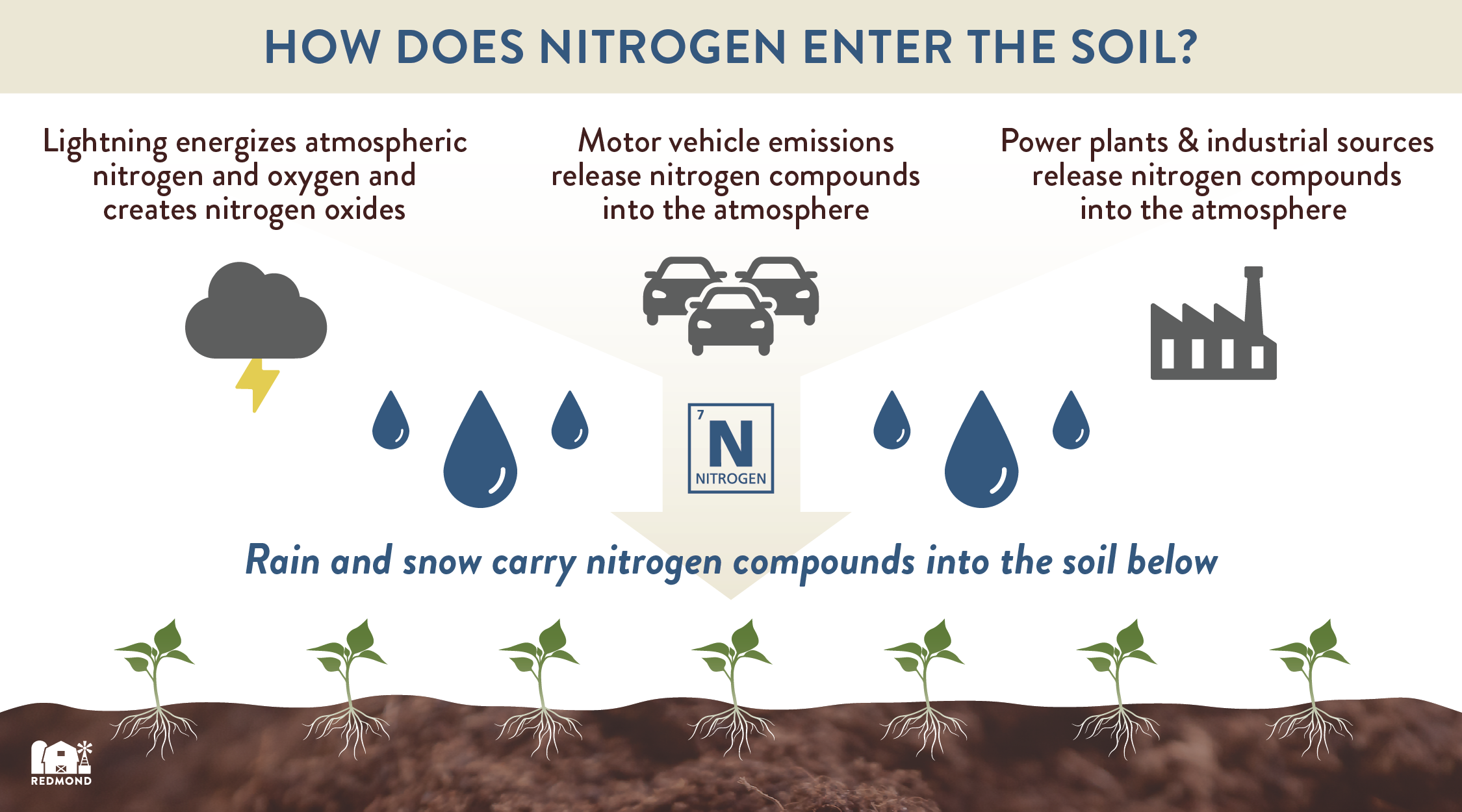
Once the nitrogen is in the soil, a vast network of nitrogen fixing and ammonifying bacteria get to work converting it into compounds that are beneficial to plants and the rest of the soil ecosystem.
How Does Soil Lose Nitrogen?
Nitrogen is in a continuously rotating cycle and does not just live in the soil forever. Knowing how it leaves your soil can help you mitigate some of this loss:
- Denitrification- Denitrifying bacteria convert it back into N2 molecules and release it into the atmosphere.
- Runoff- Watering and heavy precipitation wash away nitrogen (and other nutrients) from the top layers of soil.
- Leaching- Nitrogen compounds leach into deeper soil making them unavailable to plant roots (which is worsened by poor soil structure and texture).
- Immobilization- Plants and soil based organisms use nitrogen compounds for their own biological purposes.
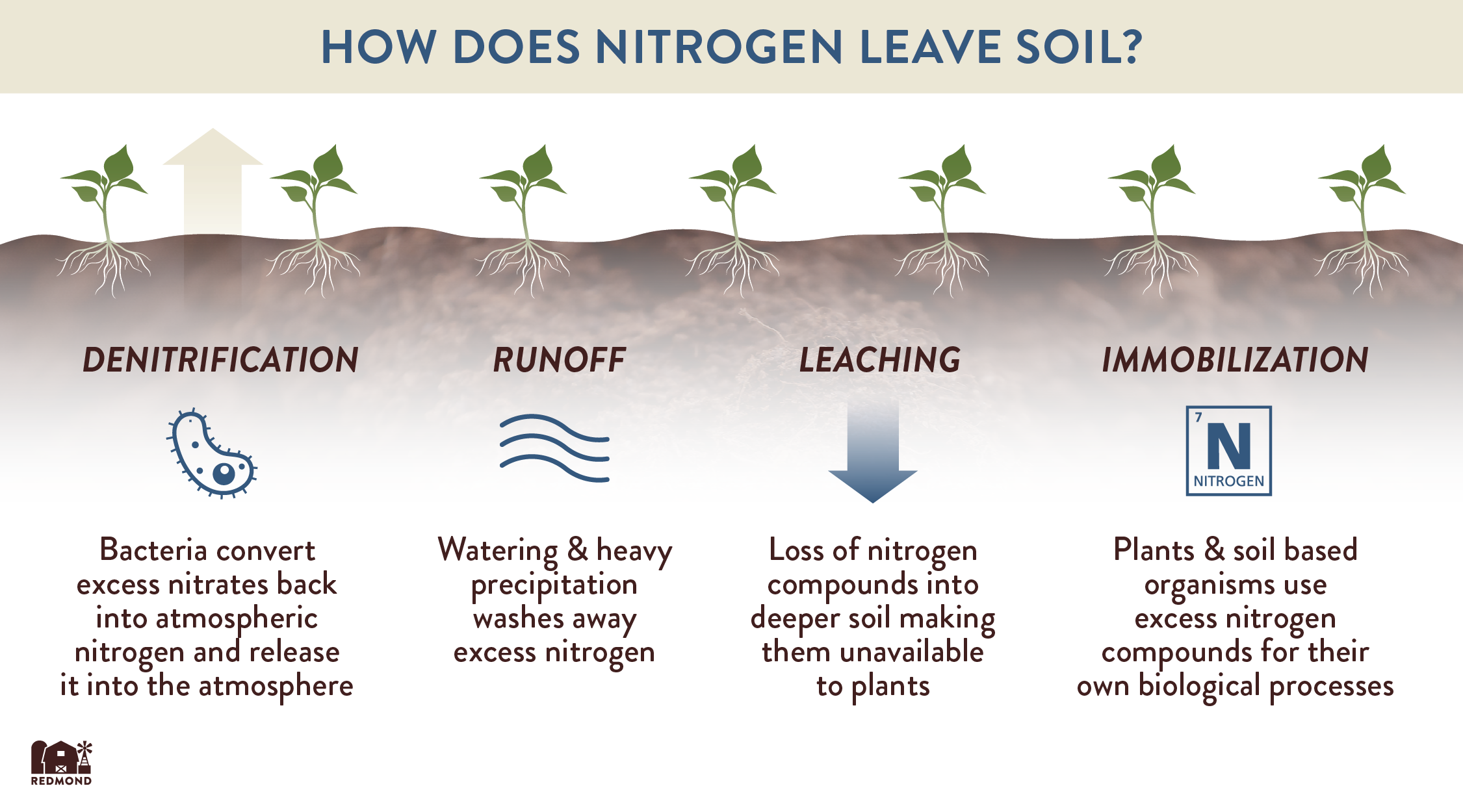
Now, we can’t (and shouldn’t) interfere with the denitrification and immobilization of nitrogen in our soil. However, there are several growing strategies that can reduce nitrogen loss from runoff and leaching, and help your plants better use the nitrogen in your soil…even during a fertilizer shortage.
How to Nourish Soil During a Nitrogen Fertilizer Shortage
First, Test Your Soil
Running a quick soil test can tell you how much nitrogen you are currently working with. Once you know your nitrogen levels, you can amend accordingly and avoid misapplication. Your soil may be in better shape than you think!
Support Soil Bacteria
Maintaining healthy soil bacteria is one of the most important steps you can take to get the most out of your nitrogen. These nitrogen fixing and ammonifying colonies need to be actively metabolizing and reproducing to keep the nitrogen cycle moving. Increasing your soil’s electrical conductivity (EC) with sea minerals will stimulate bacteria colony growth and keep those nitrogen factories going.
Improve Soil Texture
Poor soil texture increases nitrogen loss as it is stripped by runoff or leached away. Applying soil amendments like humates, volcanic ash conditioners, mulch, compost, and manure can improve soil texture and help hold nutrients (like nitrogen) where plants can reach them.
- Learn more about amending your soil.
Avoid Overwatering
Watering responsibly can reduce runoff and prevent nitrogen and other nutrient loss. Use water timers, smart irrigators, and drip systems to make sure you don’t over saturate your soil. Avoiding overwatering will also reduce nutrient pollution in your local waterways, caused by fertilizer runoff.
Plant Legume Cover Crops
Legumes hold a special place in the nitrogen cycle. These plants have unique nodules in their roots that house nitrogen fixing bacteria. Planting cover crops is also an effective way to reduce weed growth and nutrient runoff from bare soil.
- Browse through a list of cover crops from the USDA.
How Redmond Can Help Maximize Your Nitrogen
Since 1958, Redmond Minerals has been proud to support farmers and growers with our rich deposit in central Utah. Through lean and lush times, our soil program has helped growers increase plant yields, grow more nutrient dense crops, and provide sustainable soil health.
Our soil products can help put the nitrogen cycle to work for you and your plants.
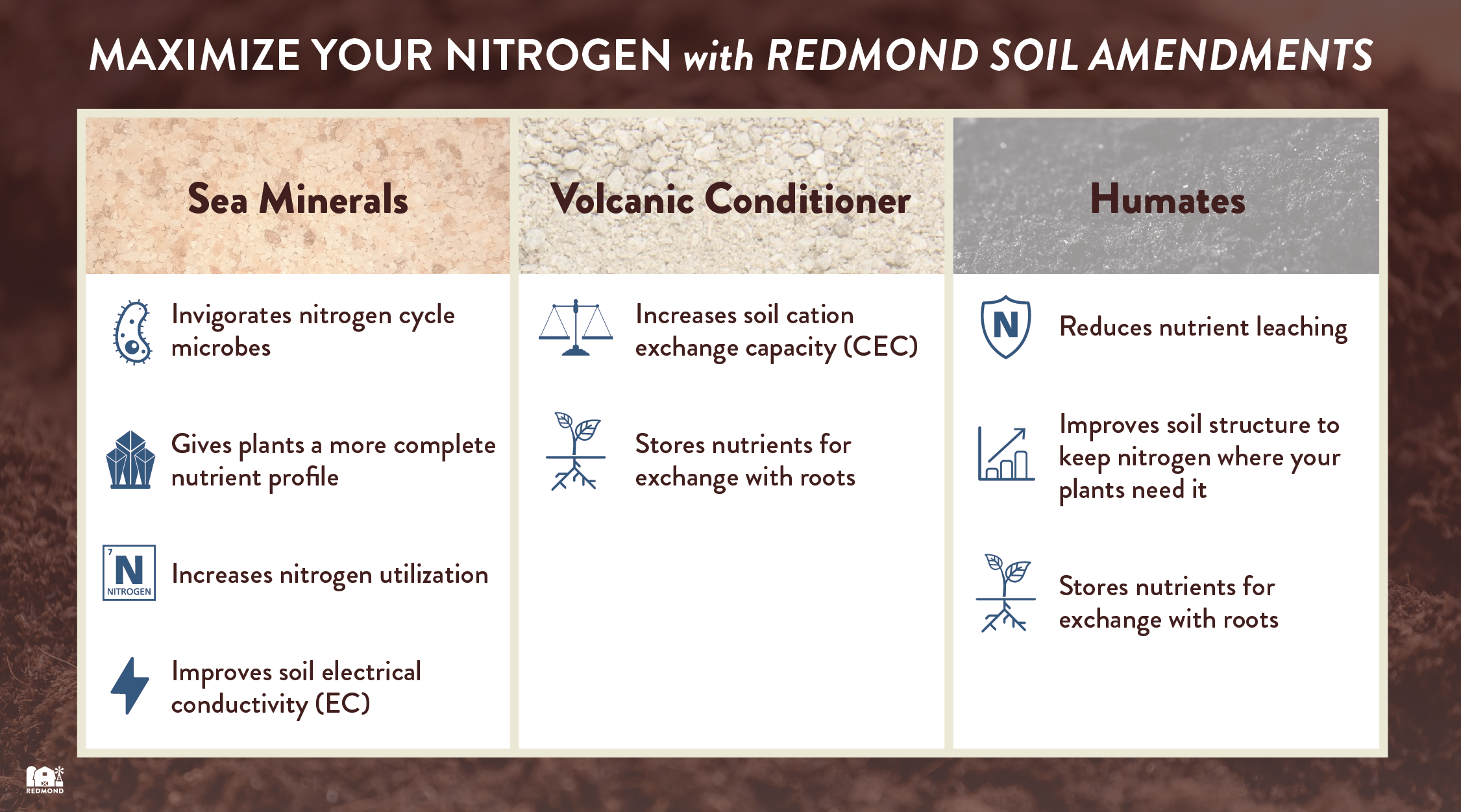
Redmond’s soil products provide the best Mother Nature has to offer. Redmond's Mineralyte soil amendment offer all 3 of these amazing resources in a single package!
- Full spectrum of sea minerals: to invigorate nitrogen fixing bacteria, increase EC levels, and provide a more complete nutrient profile that just NPK (nitrogen, phosphorus, potassium)
- Volcanic conditioner: to improve your soil’s ability to store and exchange nutrients with plant roots (increase cation exchange capacity, CEC)
- Humates: to further increase your soil CEC levels, and improve soil structure so nitrogen stores stay where plants need them the most
Give Redmond a call today at  to see how we can help you better tap into the nitrogen cycle and get back to what you love about growing!
to see how we can help you better tap into the nitrogen cycle and get back to what you love about growing!
© 2024 Redmond Minerals Inc.

